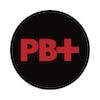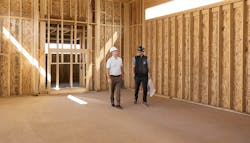2024 Builder of the Year: Camelot Homes
This article first appeared in the November/December 2024 issue of Pro Builder.
If there was ever a home builder that had earned the right to rest on its considerable laurels—award-winning and envied designs, a two-generation reputation as a market leader and innovator, and national recognition for elite operational acumen—it would be Camelot Homes.
Instead, the Scottsdale, Ariz.-based company almost everyone, including other builders, considers excellent continuously strives for better, from the smallest detail to the most audacious goal.
“Thriving isn’t just the goal, it’s the minimum accepted standard,” says Adrienne Olcott, Camelot Homes' director of human resources. “And we got to that point because we identified that it’s not the superficial things [that matter]. It’s not what everyone else is chasing. And it’s not just the look of it.”
Where to Begin?
The challenge in telling Camelot’s story is that it’s so interconnected. While there is a linear aspect to the company’s 55-year journey, its path to the present links continuous improvement to a unique approach to succession planning and a diversification strategy that reflects a legacy of luxury extending well beyond the builder’s homes.
The market reputation and truly balanced yin/yang working relationship they forged continued with their son Mark and his wife, Julie, now Camelot’s co-managing directors. Mark and Julie proceeded to build a powerhouse luxury production brand that’s now poised to pass down to their daughter, Cammie, and sons Trent and Chase.
“He said, ‘I always wanted to do that, I’ve always wondered what NHQA was and what’s involved,’” Julie recalls.
And once they looked deeper into how that program examines and evaluates every aspect of a home builder’s business practices and performance, earning NHQA Gold became the catalyst for much of what followed.
“It was the ‘hairy, audacious goal’ that Mark had been looking for,” says Jonathan Slain, founder of Autobahn Consultants, a strategic planning firm.
Camelot had engaged Autobahn a year or so earlier (on Cammie’s recommendation) to help the home builder develop strategic process and planning habits. “It was incredibly unifying,” Slain says, while also inspiring significant steps forward.
“You think you’re doing fine and then you realize you can do so much better,” says Mark of the process of applying and then being critiqued by a jury of high-functioning peers. “And that’s why I’m so passionate now about how much better we can be, even after earning Gold,” which the company achieved last year.
The Camelot Way
Between NHQA and Slain’s business coaching, Camelot developed an approach that enabled the builder to see and take advantage of new opportunities while reducing its risk of operating solely in the competitive luxury home production niche.
They call it the Camelot Way.
It charts everything from a cadence of planning and report-out meetings and goal-setting to a culture of accountability, transparency, and trust. And, it underscores an expectation that everyone on the company’s org chart comes to work with a can-do attitude, a problem-solving mindset, and a promise to do the right thing.
The method has calmed the madness, with tangible results.
Consider, for instance, the war to attract talent. “It’s very easy for us to meet the expectation of a preferred employer,” says Olcott. High performers want excellence, she says, and in addition to delivering excellent quality in the homes Camelot builds, candidates see how the company cares for its people and customers. “They see a springboard to greatness.”
Says Jamie Taylor, who works with Cammie on the relatively new Cameron Custom division, “Most builders are hesitant to step out of the proverbial box,” he says. “But with Camelot, thinking and operating outside that box is mandatory.”
While that sentiment extends company wide, it perfectly suits Camelot’s devotion to design leadership that sets trends instead of following them. “Every trend starts out at a high level of design,” says Julie, “But then people rip it off and build it cheaper in production to the point where it gets oversaturated and consumers hate it.”
“In this industry, nobody wants to be first and fail (and) everybody wants to see something succeed and then copy it,” adds Trent, drawing an analogy between that scenario in home building and his pre-Camelot career as a professional musician. “That’s something we’ve been really good at, pioneering rather than copying”—and rarely failing.
To stay ahead of the market, Camelot not only seeks out leading residential architects and designers but also challenges them to do something distinctive and create the next big thing.
“It’s a love/hate relationship,” says Mike Brekke, Camelot’s director of design and development who, along with Mark and now Trent, critiques and tweaks initial drawings to the last detail before releasing them to production. “We beat the hell out of them, but more than once an architect has told us we made them better in the process.”
Even Camelot’s day-to-day is about getting better: the design center honing its finish selection process and programming its website to allow users to save images to their Pinterest boards as a handy indicator of their style preferences; combing pre-submittal consecution drawings with key trade partners to identify and rectify potential conflicts during the build; augmenting a rigorous internal construction quality protocol with a third-party home inspector and a quality assessment firm; and implementing a video-driven tool to assess and coach the sales team to refine their craft.
That last item came from director sales Leela Smith when she assumed leadership of that team in 2023, one of several initiatives she used to improve Camelot’s acumen in that area of the business.
“We were lacking a little bit of structure to help the team focus more on discovering a homebuyer's needs and gain confidence to ask for the sale,” says Smith. “We're doing a lot of sales training that we didn’t have before, and [the team] is really motivated right now.”
Always evolving, the way Camelot does business, both internally and externally, will serve as the foundation for its future.
“Now, how do we take the Camelot Way and format it for a smooth succession from one generation to the next?” says Slain, a process that also needs to be uniquely Camelot’s. “There’s no book that you can read, no program that you can plug in. It’s really just taking what they already do and figuring out how to do it better.”
Planning for Success(ion)
Passing the torch from one generation to another in a family-owned business is often tricky and often mishandled—a scenario Mark and Julie sought to avoid. In fact, their goal was not so much to eventually cede the company to their kids, but to sustain the Camelot name beyond their tenure.
“They all had other careers first, which was really important to us,” says Julie. “They didn’t just come into the family business from the beginning.”
But as Cammie, Chase and (eventually) Trent found their way into the fold after testing different waters, their parents took a thoughtful, patient, and low-risk path to get them up to speed, uncover their skillsets, and help them succeed.
“We looked at each other and asked, ‘Are they ready to really run this company?’ Well, they’re interested, but they also have a lot to learn, a lot to make up,” she says. “So, what can we do?”
Mark and Julie’s biggest move was building a strong bench of leadership beyond their own. Following the retirement of longtime employee Tom Kirk, who wore a trio of C-level hats simultaneously, Mark and Julie hired Kevin Rosinski away from Toll Brothers’ Arizona division to serve as COO and nabbed local real estate lender Paul Engler to be CFO.
They also brought on Olcott to run HR, Leland Grisé to head up purchasing, Ryan Benscoter to oversee land acquisition, Smith as a senior sales associate and eventual director of that team, and, most recently, Rudé Van Eck as Camelot’s first dedicated marketing manager—all of them from outside the company.
“Once we had Kevin and Paul and a few other key positions on board, I felt like, okay, if Mark and I get hit by a bus, they would help mentor the kids and they can all can grow together,” says Julie.
If not outright skeptical, HR director Olcott was at least a little wary about the impact of so many new faces in so many leadership positions.
“I fully expected we would crash and burn on at least one or two of those critical positions because they were coming from much larger organizations with a very clear intent of change,” she says, speaking from experience with generational changeovers. “But it’s a testament to Mark and Julie’s lack of ego and their confidence in what they’ve built and why they’re doing it that it’s worked out as well as it has.”
It also helped that the infusion of top-tier management talent was balanced by the insider insights and experience of Brekke (a 41-year employee) and customer relations director Russ Dollman (a 19-year company veteran), among others with deep Camelot roots.
“I want to help get them to that point of leading the company,” says Rosinski of the next generation of Hancocks. “I think the torch is lit and is in the process of being passed, and I don’t see it burning out anytime soon.”
Camelot Homes' Risk Diverse Approach
As the succession plan plays out, the risk of relying solely on the luxury production arena drove Camelot to diversify the business, which, in turn, created opportunities for the next generation to explore opportunities, find their place, and prove their mettle.
“When I first started talking to Mark and Julie about joining Camelot, they already were having conversations about revenue diversification strategies,” Engler says. “But I was able to offer my experience looking at various asset classes and seeing how other companies that survived downturns or diversified or were successful in certain environments,” to help refine their initial thinking and evaluate possibilities.
Julie is much less shy about his contribution. “He created this incredible economic forecasting model to anticipate market changes so we either don’t get over our wing tips or be so conservative that we miss opportunities,” she says. “Before, we were kind of shooting in the dark, but now we’re ready.”
“I told her we didn’t do remodels, but when I started thinking about it, I could see the potential for it and a custom-building division,” she says, recalling prospective buyers who asked her if Camelot would build one of its latest models on their lot, or build to the company’s standard from their set of plans. “When you start getting yourself into a new sandbox, a lot of opportunities present themselves.”
The just-hired Rosinski helped guide the new venture, from forming a business plan to attracting Taylor away from a rival builder to run operations while Cammie focused on marketing and sales.
“That was a game-changer for me,” she says. “It professionalized the game plan. And allowing me to get the name out there while Jamie managed operations was pivotal.”
Next came Trent, who up until his early 30s showed no interest in joining the family business. “He’d get annoyed when we talked business at the dinner table,” recalls Cammie. “Until one day he’s playing golf with our dad and tells him out of the blue he wants to join the company.”
His first test: close a community on the cusp of build-out; a relatively easy assignment that, at worst, saved Mark the cost of an outside salesperson. Trent booked four sales in his first week.
“I’m training him, and he closes four sales in his first week,” says Cammie, who then was left to file the paperwork while Trent enjoyed the weekend in San Diego. “I’m like, how do I go from being his boss to being his administrative assistant?”
That success not only allowed Cammie to cede the sales and marketing role to Trent, but more confidently find her niche in the start-up custom division.
Even so, Trent, whose sensitivities and talents align more with their father’s, wasn’t long for that career path. After gut-remodeling two homes that Camelot now offers as short-term luxury rentals called Sky, Trent turned his attention to fleshing out what Rosinski identified as a possible niche of homes priced under $1 million —far less than what Camelot’s flagship brand produces.
Trent was all in. “I thought we could do some really cool architecture, something that really doesn’t compete with others at that price point because it’s so different,” he says.
Around the same time, Julie was considering a 12-acre infill site in a somewhat sketchy Phoenix suburb for her new single-family build-to-rent (SFB2R) venture. “It really didn’t pencil out for that, but I thought it would work for Trent’s first project,” she says. “I told him, ‘This is your baby, from land development through sales.’”
That directive was tested when Trent presented floor plans and elevations by a forward-thinking architecture firm that were akin to Scandinavian modern, with steep pitched roofs and stark white façades—a stark departure from Camelot’s southwestern design aesthetic.
“I was thinking, if we play it safe, no one is going to look twice at something priced under $800,000 in that neighborhood,” Trent says. “So, my thought process was to do something really unique that didn’t have to please everyone. We just had to find 12 people to love it.”
He also got a thumbs up from an architect both Mark and Julie respected. “He said it was going to be a spectacular success or a spectacular failure, but either way, Trent was going to make a name for himself,” Julie says.
Despite building and selling during Covid (which also honed his purchasing acumen), Trent’s risk was rewarded when Paradigm quickly sold out ... and launching the G3 (“third generation”) division for Camelot.
Meanwhile, the company’s foray into SFB2R, primarily as a fee builder for an investment group, is not only diversifying the revenue stream but also Camelot’s trade base and geographic footprint, which may present more opportunities to grow.
The SFR division also dedicated to building homes for less than $90 per square foot, a discipline that uncovered efficiencies that Grisé applied to the other divisions without sacrificing the brand.
SFR also afforded Camelot an enviable level of flexibility to further balance risk. “We could sell them, take the equity as a profit for the partnership, keep collecting rent, or have someone buy us out,” Julie says. “That’s not the case with the core business.”
It also eased Engler’s mind about the company’s ability to weather inevitable housing cycles. “We have five business lines that are all growing and making this a completely different company from a revenue standpoint,” he says. “It’s setting us up to really grow to a completely different level and hopefully one that’s incredibly long lasting.”
A Legacy of Luxury
When anyone at Camelot refers to its “legacy of luxury,” the conversation starts with J.W. and Maggi Hancock’s vision, but then quickly stretches far beyond the thousands of homes the company has built to encompass what it has and continues to strive toward.
That legacy includes and continues to focus on a first-in-class customer experience, a dedication to design that applies to across its divisions, and maintaining relationships with key partners while always on the lookout for others that can contribute.
“We have a lot of vendors that we’ve been working with for years that’ll do pretty much anything we need,” says Nancy Rhea, manager of Camelot’s design studio, a separate building across a courtyard from the company’s headquarters. “But we also visit their showrooms a couple of times a year, because they always have new products we can rotate into our offerings and stay innovative.”
And give Camelot first bite at it. “Vendors get to know our taste and style and what we’re specifying and so when they see something we’ve been looking for, they let us know right away,” adds Kristen Hancock (no relation), owner/director of Guided Homes Design, an interior design firm that works out of the builder’s design studio in partnership with Rhea’s crew, Brekke, and others at Camelot.
“The Camelot brand extends to them,” says Rosinski. “They want to be part of that brand.”
From a product design standpoint, Camelot is following up on its success with a post-Great Recession community called White Horse where it introduced ground-breaking floor plans that attracted a thousand people per week. The Edge at Joy Ranch, a new, 52-unit, Camelot-only project, further pushes the envelope.
Meanwhile, Trent’s next G3 venture is an eight-unit project called Viridian. Located on an infill lot in midtown Phoenix, it will showcase a pair of plans with distinctive butterfly roofs designed by Woodley Architectural Group.
With all of the recent changes in leadership (and more to come as Mark and Julie contemplate retirement) and diversification in product and process that will challenge more long-held norms, the Camelot Homes founded by J.W. and Maggie Hancock 55 years ago is morphing rapidly into a vastly different animal, and yet determined not to lose sight of its enviable legacy.
“We’re planting the seeds knowing we’re not harvesting this year, but putting in the effort and the resources, the right people, the training, and the clarity to meet the future,” says Olcott. “But we’re keeping the heart that’s made us who we are.”
About the Author
Andrew Hunt
Andrew Hunt writes about building science and the built environment.

Rich Binsacca
Rich Binsacca is editorial director of Pro Builder Media and Custom Builder Online. He has reported and written about all aspects of the housing industry since 1987 and most recently was editor-in-chief of Pro Builder Media. [email protected]


















